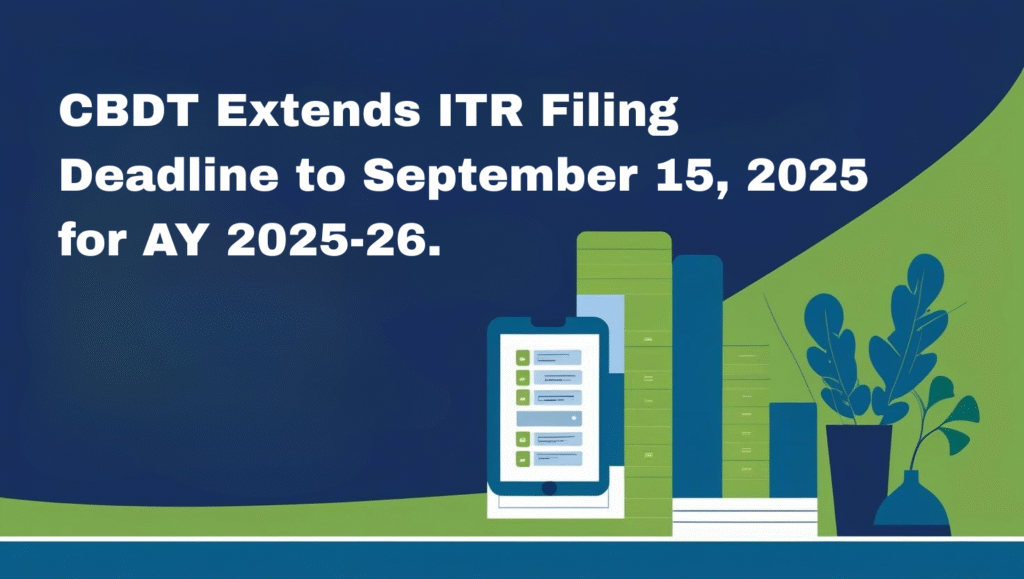
In India’s taxpayers extended relief, the Central Board of Income Tax (CBDT) has postponed the due date for filing Income Tax Returns (ITRs) for the financial year 2024-25 (Assessment Year 2025-26) from July 30, 2025, to September 15, 2025.
The move, notified on May 8, 2025, fulfills demands arising from far-reaching changes in ITR forms, tardiness in e-filing utility releases, and the necessity of proper reflecting Tax Credits, making the filing process more seamless for millions of non-audit taxpayers in India.
The expansion is to tax assessees under clause (c) of Explanation 2 to Section 139(1) of the Income-tax Act, 1961, which includes mainly individuals, Hindu Undivided Families (HUFs), and partnership firms which are not required to be taxed under a tax audit.
The salaried employees and small business owners reporting ITR-1 (Sahaj) or ITR-4 (Sugam) fall under this category, which covers individuals with incomes up to ₹50 lakh from salaries, one house property, or presumptive income from business.
The CBDT action, through Circular No. 06/2025, addresses stakeholder anxiety, especially that of the chartered accountant fraternity, regarding the time required for transitioning to newer systems.
The ITR forms for FY 2025-26 have been drastically restructured and reworded with a view to streamlining compliance, increasing transparency, and enhancing reporting accuracy.
Other significant amendments include rationalized disclosures of capital gains, where taxpayers will have to split gains into gains accruing before or on and after July 23, 2024, as a result of Budget 2024’s changes in tax rates.
For example, long-term capital gains on immovable property are currently taxed at 12.5% without the benefit of indexation as compared to 20% with indexation earlier. The ITR-3 threshold for reporting assets and liabilities has doubled to ₹1 crore to lighten the load for middle-income taxpayers, and the easier forms now handle capital gains of up to ₹1.25 lakh.
System readiness has also been a major reason for the extension.
The CBDT mentioned that significant upgrades to e-filing utilities involving system integration and testing need to be done in order to incorporate these form changes. In addition, tax credits from returns to be filed by May 31, 2025, will only become available in early June, reducing the filing timeframe without extension.
“This extra time helps taxpayers authenticate Form 26AS, match tax information, and file returns correctly without the pressure of last-minute rushing,” V. Rajitha, Commissioner of Income Tax (Media & Technical Policy), said in a press statement.
The extension of providing an additional 46 days has received widespread acceptance. X posts reflected relief, with users such as @IncomeTaxIndia posting, “CBDT extends the due date of filing ITRs to 15th September 2025, ensuring a smoother filing experience.” Chartered accountants who had expressed concerns over delayed utility software welcomed the news, although some, such as @CAamanmittal, called for a corresponding extension of the deadline for filing the tax audit report, currently fixed for September 30, 2025.
Taxpayers are requested to make the most of the additional time. Not filing on September 15 has a penalty of ₹1,000 for incomes of up to ₹5 lakh or ₹5,000 for greater incomes under Section 234F, plus 1% interest per month on unpaid tax under Section 234A. Late returns can be submitted up to December 15, 2025, but not loss carry-forward.
Revised returns, correcting errors, are also due by December 15, 2025, while updated returns via Form ITR-U extend to four years for reporting additional income.
The proactive move by the CBDT fits into India’s overall economic thrust, highlighted by a 7.4% growth in Q4 FY25 GDP. By focusing on ease of compliance, the extension aids taxpayers to navigate fiscal obligations in the context of structural changes. Experts suggest checking Form 26AS, matching tax credits, and taking expert advice to maximize deductions, especially under the previous tax regime, requiring timely filing to exit the default new regime.
As India’s digital tax landscape matures, with more than 1.5 million filers reporting through channels such as ClearTax, the CBDT’s move is one of embracing a taxpayer-oriented procedure.
With formal notification out, taxpayers now have sufficient time to make penalty-free, accurate filings, bolstering confidence in India’s tax authorities.
